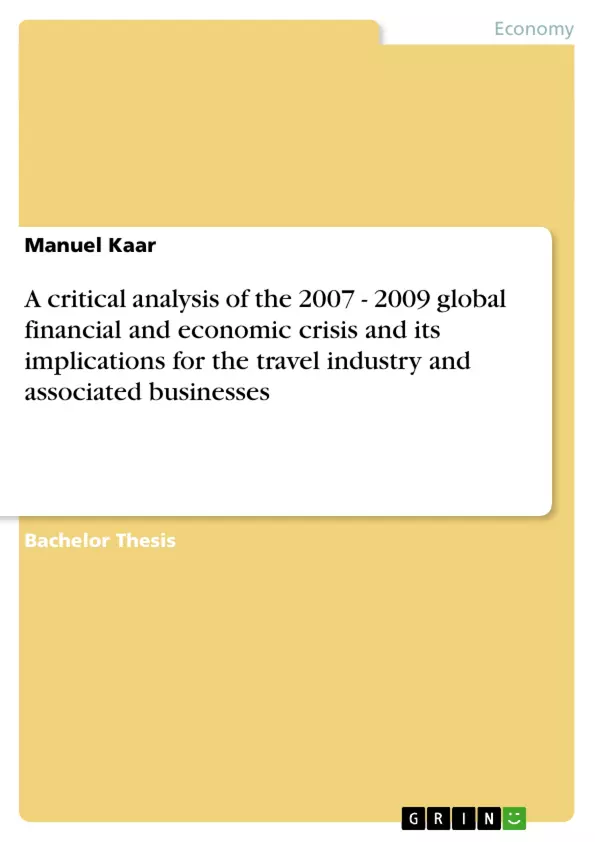There have been numerous incidents in one or more countries in the past that led
to sudden and unexpected reductions in demand for tourism services and
confronted travel businesses with an economic environment of high uncertainty.
However, the current financial and economic crisis appears to be of a larger
dimension than most other crises before, and numerous experts around the globe
agree that the present economic slowdown has the potential to become one of the
most challenging and transformational disturbances on a supranational level since
the Great Depression. Predictions of future developments are vague and can only
be educated speculation at best, yet for the tourism industry the initial effects of
this first major crisis of the globalization era are already clearly perceptible.
Drawing on an extensive review of already existing literature, this paper explains
the various milestones during the period that led to the 2007-2009 global financial
and economic disorder, and subsequently considers a choice of selected key
implications for the tourism industry and associated businesses. The aim of this
paper is therefore to provide an academically substantiated reference guide for
market participants and policy-makers alike, with the ultimate purpose of making a
contribution to reduce the number of cases where wrong decisions lead to major
difficulties or even the failure of a destination or an individual business.
Results of the research indicate that the identified impacts are likely to intensify
throughout 2009 and 2010, and that the crisis will most likely also entail
fundamental changes for the industry on a long-term basis. In particular, it was
found that in the medium term decreased public funding for tourism projects and
restricted access to capital are likely to force many travel businesses into serious
liquidity problems. This may cause a series of reactions, including widespread
workforce reductions and severe cuts in the quality of the provided services.
Besides, the crisis is likely to have considerable effects on the way leisure and
corporate travel is conducted, as for instance shorter and less frequent trips or a
stronger tendency towards cost containment. However, the paper also points out
that every crisis embodies a great number of opportunities and provides an
analysis of a range of selected chances for destinations and tourism businesses.
Inhaltsverzeichnis (Table of Contents)
- INTRODUCTION
- HOW THE 2007-2009 GLOBAL ECONOMIC CRISIS EVOLVED
- Recent historical background
- The problem of sub-prime lending
- The end of an era
- Effects of the financial crisis on the real economy
- RESEARCH METHODOLOGY
- IMPACTS OF THE CRISIS ON THE TOURISM INDUSTRY
- General aspects
- Key negative impacts
- Decreased public funding for tourism projects and infrastructure
- Restricted access to capital
- Excursus: Unemployment in the tourism industry
- Changing patterns in leisure travel
- Changing patterns in corporate travel
- Selected possible opportunities
- Shift in source markets
- Intensification of the trend towards 'Smart tourism'
- New spirit of companionship
- Other opportunities
- DISCUSSION AND CONCLUSIONS
Zielsetzung und Themenschwerpunkte (Objectives and Key Themes)
This paper provides a critical analysis of the global financial and economic crisis of 2007-2009 and its implications for the travel industry and related businesses. The paper examines the origins and evolution of the crisis, focusing on the role of sub-prime lending and the subsequent impact on the real economy. The main objective is to understand how the crisis impacted various aspects of the tourism industry, including travel patterns, funding for tourism projects, and the availability of capital. The paper also explores potential opportunities that may arise as a result of the crisis, such as shifts in source markets and the rise of "smart tourism." * The origins and evolution of the 2007-2009 global financial and economic crisis * The impact of the crisis on the tourism industry, including negative impacts and potential opportunities * The changing landscape of travel patterns, both leisure and business * The role of "smart tourism" in the post-crisis era * The importance of understanding the macroeconomic factors that influence the tourism industryZusammenfassung der Kapitel (Chapter Summaries)
The introduction provides a brief overview of the topic and its significance. Chapter 2 delves into the origins and development of the 2007-2009 global economic crisis, exploring the role of sub-prime lending, the housing market bubble, and the subsequent impact on the real economy. Chapter 3 outlines the research methodology employed in the paper. Chapter 4 examines the impacts of the crisis on the tourism industry, identifying both key negative impacts such as decreased public funding and restricted access to capital, as well as potential opportunities, such as a shift in source markets and the rise of "smart tourism." The paper concludes with a discussion of the key findings and their implications for the future of the tourism industry.Schlüsselwörter (Keywords)
The paper focuses on the following key topics: global financial crisis, sub-prime lending, tourism industry, travel patterns, smart tourism, destination marketing, economic impacts, crisis management, and potential opportunities. The paper examines the macroeconomic factors that influence the tourism sector and highlights the importance of understanding the interconnectedness of global economies.- Citation du texte
- Manuel Kaar (Auteur), 2009, A critical analysis of the 2007 - 2009 global financial and economic crisis and its implications for the travel industry and associated businesses, Munich, GRIN Verlag, https://www.grin.com/document/136865



